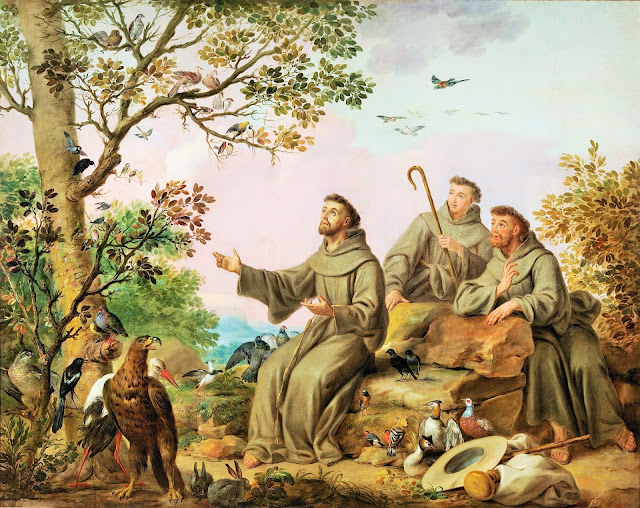Saint Francis Preaching to the Birds 1788
Saint Francis´s sermon to the birds is one of the most popular episodes from his life. In his biography of that saint (chapter XXI, 58), Celano narrates the event that occurred near Menavia in the Espoleto Valley, when Saint Francis addressed the birds, praising them for their divine goodness in relation to their existence, a theme that has allowed the painter to represent a large number of birds in the painting.
Some of the most interesting are found in the tree on the left, in the thickest branch that grows to the right, above the goldfinches and swallows that are perched on the branch. This branch forks into two, the one that goes further down has two specimens of turtle dove perched on it, very large in proportion to the real species.
There is no evidence that there were turtle doves in the Iberian Peninsula during the artist's time, and the models used by the artist to represent them are unknown. It is thought that perhaps they were raised as cage birds, or that they were a souvenir of a trip, or a copy of a picture. This species was sighted for the first time in Spain, in Asturias, in 1960. At the base of the tree, in the foreground, a golden eagle stands out, and behind it a common stork.
To the left of its white back is a magpie and above it on a short branch is a red partridge and a small yellow bird that looks like a cattle wagtail. Above this pair, a twig crosses in front of the trunk to the right. On that twig, more or less at the height of the saint's right hand, there are three goldfinches - those with the reddish forehead - and three swallows - those with the forked tail -, in addition to a possible stonechat that has a chest pink.
Under the saint's right hand, we see a white lapwing with a black collar, while a pair of doves rest on his thigh. Behind the saint a pair of spotted starlings, dark and with spots. The little red and black bird below has a very typical white spot on its head and is, therefore, a real redstart.
On the ground, next to the hat, there is a small red-black pair, which is the closest to the saint and which are two bullfinches. Next to them, larger and with a black-and-white back, is a large hoopoe. Next, with a reddish neck and a crest, are a pair of great crested grebes. The last one on the right cannot be identified with complete certainty, although the reddish eye patch looks like that of a Nile goose (Text extracted from Gómez, J. et al.: Las Aves en el Museo del Prado, 2010, p. 197 ).



Comments
Post a Comment